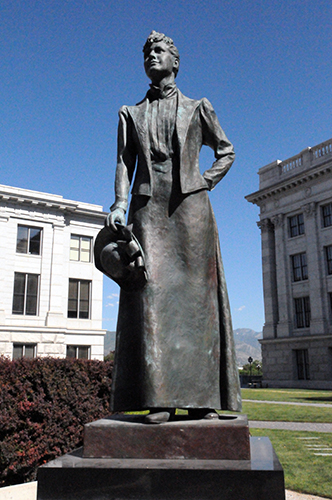SALT LAKE CITY — Call it Martha vs. Philo.

Sen. Todd Weiler, R-Woods Cross sponsored a Senate Concurrent Resolution this legislative session, which passed January 29th and will now replace the statue of Philo T. Farnsworth with the statue of Martha Hughes Cannon in the U.S. Capitol. This decision spurred debate about who’s the best representative of Utah in the nation’s capital, and in the Senate, Cannon won.
Farnsworth was an inventor and pioneer of television. Cannon was the first female state senator in the United States, a doctor, a polygamist wife and a woman who ran a campaign against her own husband for the Senate seat and won.
Thirty years ago, a class of elementary students from Ridgecrest Elementary School and their Principal Bruce Barson banded together to pass legislation that brought a statue of Farnsworth to the U.S. Capitol.
Farnsworth was born in Utah but did most of his theoretical work as a high school student in Rigby, Idaho. Rigby honored Farnsworth with a Television and Pioneer Museum. Farnsworth later returned to Utah to attend BYU.
Each state is allotted two statues inside the Capitol building. Utah’s other statue entry is Brigham Young.

Cannon’s statue now stands in the courtyard of the Utah Capitol and is a hallmark of every guided tour.
“People are inspired by her story … she really puts the best foot forward for Utah,” Weiler said.
Weiler said this was not an anti-Farnsworth movement.
This resolution thanks Farnsworth for his service to Utah “but would then replace him with Martha Hughes Cannon and let her have her decades … in the spotlight,” Weiler said.
Weiler said there is no legislation mandating a statue to remain in the Capitol once it is placed there, and other states have periodically swapped out statues.
The bill met opposition in the Senate committee hearing from a Utah citizen, George Chapman. Chapman argued Farnsworth is an inspiration to young men and women who want to be engineers.
“One of the reasons I became a scientist … is because I was inspired by stories of the best scientists and engineers around the world,” Chapman said. “Philo T. Farnsworth was one of those, and I was especially proud he came from Utah.”
Chapman said he doesn’t think Utah needs more statues of politicians.
“I would rather see more statues of scientists and engineers,” Chapman said.
Following his comments, Sen. Daniel Thatcher, R-West Valley City, shared that Philo T. Farnsworth is a member of his family and a man he reveres.
“I didn’t learn about Philo T. Farnsworth because he was on a statue in Washington D.C. representing the state of Utah,” Thatcher said. “I learned about him from my dad.”
Even though Thatcher has an ancestral relation to Farnsworth, he supports the Senate Concurrent Resolution.
“While I do agree that Philo will inspire scientists, I believe that Dr. Martha Hughes Cannon … will inspire everyone,” Thatcher said.
The bill is supported by Better Days 2020, a nonprofit committed to popularizing Utah women’s history. The organization has been campaigning to encourage women of various organizations to get behind the bill.
When discussing the cost of replacing the statue, Weiler said he plans on looking to the Cannon family, Better Days 2020 and other organizations to fund it rather than charging taxpayers for the change.
“If we’re going to do this, it’s going to be with zero taxpayer money,” Weiler said.




